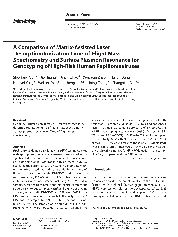摘要
Background: Human papillomavirus (HPV) testing coupled with appropriate clinical management is associated with a significant decline in the rate of advanced cervical cancer and associated death. Methods: In this present study, we evaluated the performance of 2 new HPV genotyping methods, matrix-assisted laser desorption/ionization time-of-flight mass spectrometry (MALDI-TOFMS) and surface plasmon resonance (SPR) in 30 kinds of HPV control materials and in 129 cases of cervical smears including 79 HPV-positive samples screened from 1,600 abnormal clinical samples and 50 cervical cytology samples. Results: The HPV genotyping accuracy of both MALDI-TOFMS and SPR was 100% for the HPV genotyping of control materials. In the analysis of the 79 HPV-positive samples by MALDI-TOFMS, HPV positivity was 88.6% (70/79). Nine samples were non-high-risk HPV (non-HR-HPV), which were not targets of MALDI-TOFMS. In the analysis of the 50 cervical samples, the agreement of both tests was 84% with a kappa value of 0.660. By using consensus results that mean agreement between 2 of 3 methods, the HR-HPV genotyping accuracy was 100% (77/77) by MALDI-TOFMS and 94.8% (73/77) by SPR in the 129 cervical samples. The sensitivity (88.2%; 82/93) and specificity (88.9%; 32/36) of MALDI-TOFMS were similar to those of SPR. Conclusion: These results support that MALDI-TOFMS is a sensitive, specific and feasible method for HR-HPV detection in clinical application, compared with the SPR method.
- 出版日期2011
- 单位中国食品药品检定研究院; 中国科学院北京基因组研究所; 山东大学
